It was three years ago in September when I had finally finished Music Theory for the Bass Player! And it had taken me just as long to write it! Many writing retreats to carve out time, even students giving me their keys to summer homes and huts so I could work without distraction… rounds and rounds of editing, a whole team of designers, editors and graphic artists… Wolf at my side for every step of the way… the learning curve to self publish… what a journey!
Here is how “Music Theory for the Bass Player – The Book” Came About
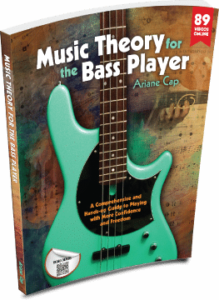 “Ari, please help me because I am stuck just regurgitating songs and licks without being able to create my own lines.” This was a very typical opening line when a new student entered my studio. Sometimes they were really good solid, and busy players, other times beginners or hobbyists who had been playing for many years; the common theme was their frustration of not really knowing how to break out of this rut and truly go beyond the plateaus, how to create their own lines and play with more confidence and freedom. To be a good teacher I always strive to be a good listener. I listened intently and
“Ari, please help me because I am stuck just regurgitating songs and licks without being able to create my own lines.” This was a very typical opening line when a new student entered my studio. Sometimes they were really good solid, and busy players, other times beginners or hobbyists who had been playing for many years; the common theme was their frustration of not really knowing how to break out of this rut and truly go beyond the plateaus, how to create their own lines and play with more confidence and freedom. To be a good teacher I always strive to be a good listener. I listened intently and
I discovered a few commonalities over and over again:
- Technique issues – when you are in your own way, the music can’t flow. Whether it is mental tension or over-gripping, you can hear it (and often see it) and it does not sound good.
- Incomplete theory knowledge and a history of frustrating attempts to remedy the situation: What IS it with the cycle of fifths? Why the modes? I just want to play better, how does this help me?
- The desire to create your own grooves but not knowing where to start. Theory seems a reasonable approach, but what if you don’t read music? Many theory books can make you feel like you’re starting over and that you know nothing!
- Relying on TAB and “show me” rather than being able to understand chord progressions and musical phrases, and grooves and fills and how to create your own bass lines.
It got me thinking. I had been teaching systematically for years and knew exactly how to close those gaps:
First of all, do not try to learn to read music at the same time as you learn music theory. But if you pick up many music theory books they will look the same:
- Okay, so, page one, this is the treble clef (“Every good boy does fine”), page 2, this is the bass clef (“Good boys do fine always”) – got it?
- And on page 3, we learn the rhythm pyramid. So far so good, makes sense in theory.
- And on page 4, we start with music theory – scales, arpeggios and so on – presented in standard music notation on the 5 line staff. Sometimes I’d see a diagram seemingly as an afterthought.
This is a total disaster for a bass player! Why? Two reasons:
- Learning to read is a separate skill from music theory.
Moreover, it requires a pretty good understanding of the basics of theory just to get started to read.
So the student is hit with a double whammy:
learning the theory AND learning a completely new way of picking up information from the page.I decided to go for a different approach also because learning to read is very different on the bass fretboard than on most other instruments as the same note can occur multiple times on different strings.It is essential on the fretboard to break down music theory into shapes; once you master these shapes, learning to read is much easier on bass! So, the typical music theory book which explains reading as a prerequisite and then dives into theory as demonstrated in standard notation will not be useful. Reading is an essential skill and can be taught systematically (I am already working on a book on this!). I like to treat it as a skill to learn AFTER the bassist has a good grasp of the basic theory. Reading will be much easier if you know your theory and the shapes that go along with it on the fretboard!
- This kind of approach takes the bass player back to square one, saying: forget all you know and start down this different road. I have seen it time and time again: these students actually KNOW way more theory than they give themselves credit for! Pentatonics, scales, arpeggios, modes… They are using them in songs every day!
They just do not know:
- the names for such things,
- haven’t figured out best fingering practices,
- how all these building blocks work together in an overarching framework,
- when and how to use them and to what effect,
- and they typically lack a few very important basics:
- how notes work
- how the bass is put together
- the basic building blocks of music theory (intervals! and everything that floowos from there)
- best fingering practices and great technique
So, why not start with what you know, fill in the blanks and take what you already do use every day all the way, in a systematic fashion? (It is much harder to teach that way, rather than to follow the beaten path of hundreds of years of music theory tradition, but it is so worth it for the student! And this is exactly what Music Theory for the Bass Player does)
This drove me to go ahead and put together all the material I had been successfully teaching for years and create a book. I had looked at other bass books on the market and
I was quite surprised to find:
- Gaping holes and inaccuracies in explanations that added more to the confusion than they actually helped. Particularly concerning issues that I found time and time again:
- intervals not explained correctly, especially inversions and compound intervals (That really makes your life hard if you don’t get this right. It makes everything that builds on understanding intervals too hard!)
- impractical explanation of modes (C Ionian, D Dorian, E Phrygian – who can hear that? And how do you play C Dorian? C Phrygian? And why?)
- cycle of fifths only explained as a tool to match key signatures but not as the awesome practicing tool it is, or the way it is found in songs or distinguishing between the importance of falling fifths and ascending fifths (that’s important because it shows up in chord progressions so much!)
- skipping the super important diatonic cycle of fifths
- explaining everything in the key of C or G with no effort to get students comfortable and confident all over the fretboard and in all keys
- Lack of teaching how the musical alphabet works and how the bass fretboard is organized
- Not taking into account what the student typically already knows – for example, I start with the “Big Box/Little Box” shape, a pentatonic shape most students have played in one song or another
- Mixing reading and theory teaching (learn theory first, then reading becomes a breeze!)
- Lost opportunities to tie in the importance of proper technique – since theory is essentially a collection of shapes on the fretboard (no reading required!!), why not teach best fingering practices while we are at it?
- No concern whatsoever for smart learning – to me teaching in a very specific step-by-step manner that maximizes understanding is extremely important. I think about it constantly, test (and retest) again and again to find the sequence of teaching topics that works best for most students. Yes, it will require some thinking on the reader’s part. I won’t dumb things down just because “that sells”. But the reward is awesome and I help you on the way!
- No or very little interaction with the student (my book has the very popular, sometimes very tough, sometimes tongue-in-cheek “Test Your Understanding” Questions – they are challenging, often fun and funny and very educational!)
- A very unfocused way of teaching, randomly mixing in songs, a bit of reading, incomplete “musical alphabets” and other topics, but tackling neither theory nor any of the other items in a comprehensive manner that provides the student with the empowering tool he or she needs!
- Burning pages and pages by writing out arpeggios and scales in all keys (rather than giving the student the tools to do that themselves!).
Now here is the incredible part:
several people have tried to copy my approach but have been terribly sloppy with it. There are at least two books that I know of (one by a major publisher!) that came out long after mine had been a consistent top seller on Amazon: they tried to replicate the success of mine by using buzzwords from my Amazon description or borrowing from my cover and table of contents; they say imitation is the sincerest form of flattery. Hmmm…
I would be very happy if my book inspired thoughtful and well thought out books. Educators email me often to say they use my book in their classes and it changed their outlook and understanding of teaching and that they get great results with it. I did not invent scales, shapes, and patterns, but I did carefully and painstakingly research and test systematic and comprehensive ways to teach the essentials of music theory for the bass player on the fretboard. If that inspires others to think deeply about teaching music theory on the bass, I am very happy!
But when I looked at these other books they were only trying to copy my marketing success by borrowing from the title, being a bit cheaper, using my buzzwords or parts of my descriptions. They did NOT, however, bother to understand my approach or the care with which my content is conceptualized. What did I find inside those books? Same old tired and incomplete ideas (see above bullet list!). No effort to understand why my approach is different because it carefully takes the above problems into account.
Don’t get me wrong, there are many awesome bass books out there and I am recommending them all the time: I love Standing in the Shadows of Motown, all of Chuck Sher’s Bass Books, many great transcription books, Mike Richmond for Walking Bass, Victor Wooten’s The Music Lesson…
For Music Theory for the Bass Player – come to the source and skip the copycats!
We followed up the success of the book with 89 free videos that demonstrate the concepts in the book and stream on my site; we created a corresponding wall chart as well as a coaching course (because many people shared with me that they’d like some support going through the book).
Enjoy the real thing. This is not a for-dummies-book, a sorta, kinda approach to make you sound smart but not have real knowledge. This is the real deal if you are serious about learning and are up to the challenge! Get the book here.
Happy Birthday, Music Theory for the Bass Player!
The success of this book has opened doors for me and connected me to musicians all over the world. One of the first persons to hold a test print in hand was Scott Devine of the super cool scottsbasslessons.com platform! (I have the Warwick Camp to thank for making that connection). Scott gave me the thumbs up and offered me to do seminars on his awesome platform (that every bassist should be part of, by the way!). Extra special thanks to all at scottsbasslessons.com, the folks at truefire.com who gave me the opportunity to produce a great DVD on pentatonics, and notreble.com who gave me my own platform called “Talking Technique”! Kai Eckhardt, Steve Bailey and many more have supported me and my book!
It is a frequent bestseller on Amazon in the guitar songbooks category and has 141 verified reviews at the time of this writing and a 4.7-star rating. The best sales rank on Amazon it ever occupied was in the low 4000s, quite a feat for a bass theory book!
And the Marleaux bass on the cover? It turned into my business color. It is called “seafoam green”.
I have many more books on the way that will directly tie into this one, which I consider a great start whether you are a total beginner or seasoned player. My sincerest thanks and gratitude go to my students and to you, my readers!
Get the coaching course with the book
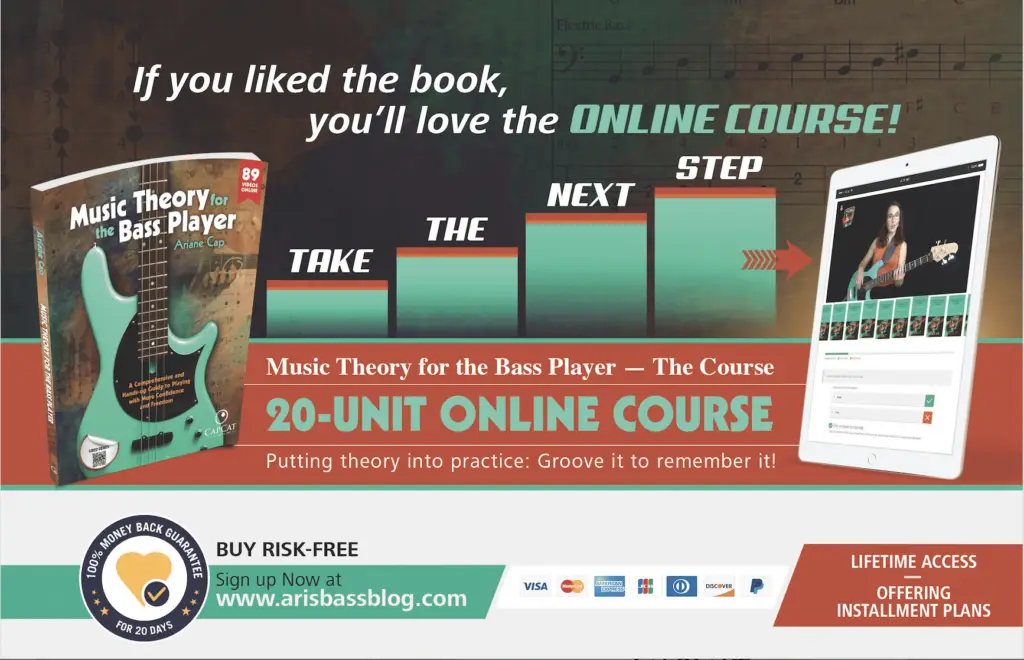
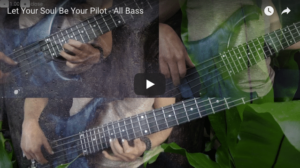

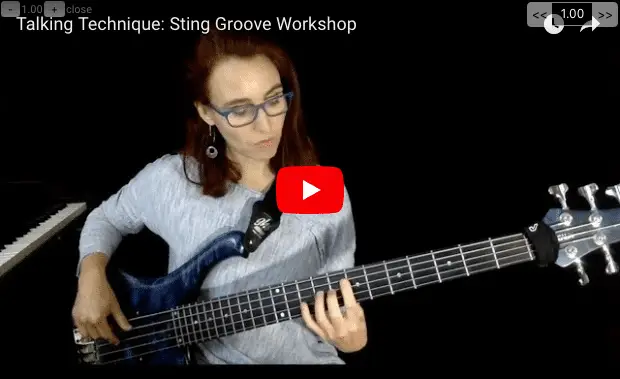

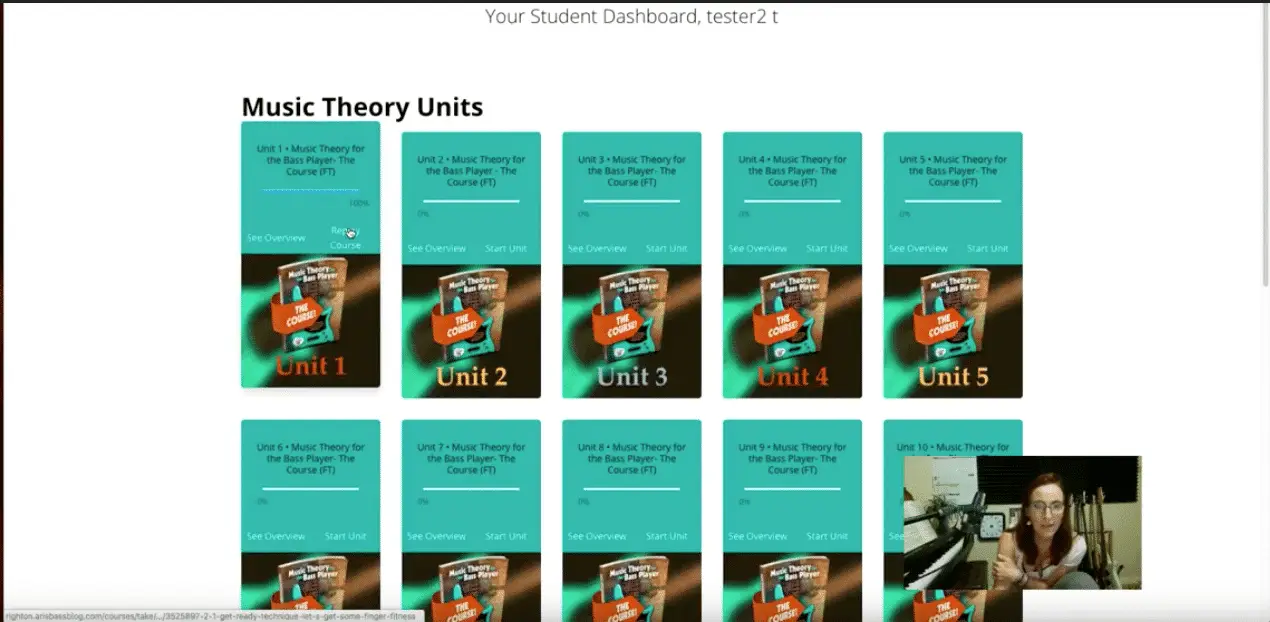




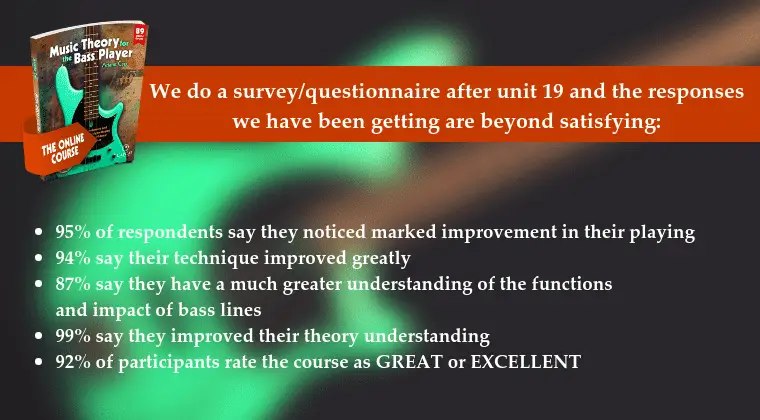
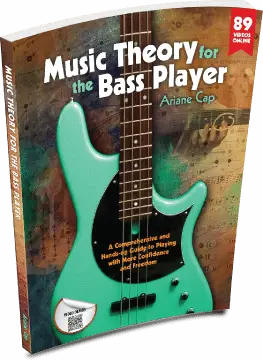
 “Ari, please help me because I am stuck just regurgitating songs and licks without being able to create my own lines.” This was a very typical opening line when a new student entered my studio. Sometimes they were really good solid, and busy players, other times beginners or hobbyists who had been playing for many years; the common theme was their frustration of not really knowing how to break out of this rut and truly go beyond the plateaus, how to create their own lines and play with more confidence and freedom. To be a good teacher I always strive to be a good listener. I listened intently and
“Ari, please help me because I am stuck just regurgitating songs and licks without being able to create my own lines.” This was a very typical opening line when a new student entered my studio. Sometimes they were really good solid, and busy players, other times beginners or hobbyists who had been playing for many years; the common theme was their frustration of not really knowing how to break out of this rut and truly go beyond the plateaus, how to create their own lines and play with more confidence and freedom. To be a good teacher I always strive to be a good listener. I listened intently and
